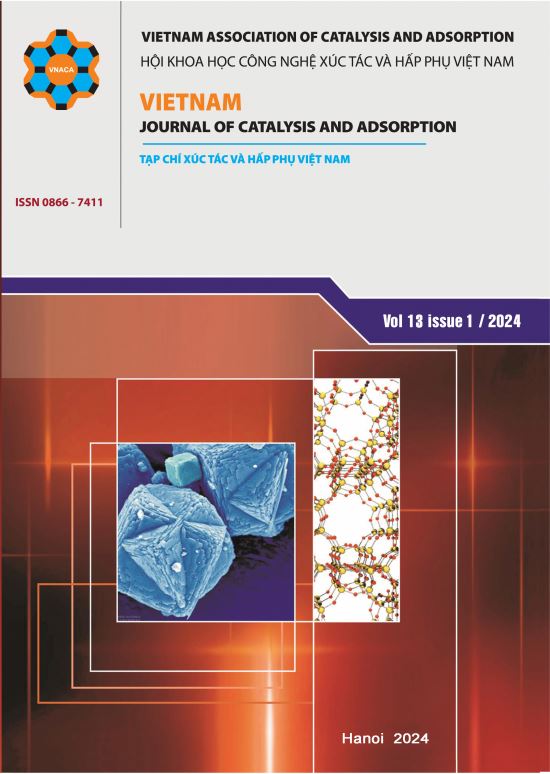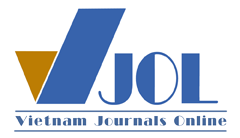Adsorptive removal of organochloride pesticide in water using surfactant modified aluminum hydroxide nanoparticles
DOI:
https://doi.org/10.62239/jca.2024.004Abstract
In the present study, an anionic surfactant, sodium dodecyl sulfate (SDS) was used to modify aluminum hydroxide nanoparticles to form a novel adsorbent (SMAH) for removal of an organochloride pesticide, Dichlorodiphenyltrichloroethane (DDT) in water environment. The DDT removal using α-Al(OH)3 and SMAH nanoparticles were 35.5, and 96.1 %, respectively indicated the high removal efficiency of SMAH compared with α-Al(OH)3. The effective conditions for adsorptive removal of DDT using SMAH were optimized and found as pH 8, contact time 30 min and SMAH dosage 25 mg/mL. The maximum adsorption capacity of DDT on SMAH calculated by a two-step model was found to be 2500 µg/g. After five regenerations, the DDT removal was still higher than 80 %. Adsorption isotherms of DDT on SMAH and the surface charge change of SMAH after adsorption demonstrate that hydrophobic interactions in the presence of SDS bilayer of admicelle is the main driving force to control DDT adsorption on SMAH.
Downloads
References
Gupta VK, Jain CK, Ali I, Chandra S, Agarwal S. Water Res 36 (2002) 2483-90. https://doi.org/10.1016/S0043-1354(01)00474-2.
Sarkar SK, Bhattacharya BD, Bhattacharya A, Chatterjee M, Alam A, Satpathy KK, Jonathan MP. Environment International. 34 (2008) 1062-10771. https://doi.org/10.1016/j.envint.2008.02.010.
Liyan S, Youcai Z, Guojian W, Bing L, Dongjie N, Xiaoli C. Journal of Hazardous Materials 146 (2007) 289-294. https://doi.org/10.1016/j.jhazmat.2006.12.041.
Khan S, Han C, Sayed M, Sohail M, Jan S, Sultana S. Catalysts 9 (2019) 425.
Jemal T, Astatke H, Terfe A, Mekonen S. PLOS ONE 18 (2023) e0288086. https://10.1371/journal.pone.0288086.
Mojiri A, Zhou JL, Robinson B, Ohashi A, Ozaki N, Kindaichi T, Farraji H., Vakili M. Chemosphere 253 (2020) 126646. https://doi.org/10.1016/j.chemosphere.2020.126646.
Sprynskyy M, Ligor T, Buszewski B. Journal of Hazardous Materials 151 (2008) 570-577. https://doi.org/10.1016/j.jhazmat.2007.06.023.
Nguyen TH, Nguyen TTL, Nguyen TC, Doan TH, Le QH, Bui QM, Le TS., Pham TD. Materials Today Communications 34 (2023) 105266. https://doi.org/10.1016/j.mtcomm.2022.105266.
Pham TD, Kobayashi M, Adachi Y. Colloids and Surfaces A: Physicochemical and Engineering Aspects. 436 (2013) 148-157. http://dx.doi.org/10.1016/j.colsurfa.2013.06.026.
Franks GV, Gan Y. Journal of the American Ceramic Society 90 (2007) 3373-88. https://10.1111/j.1551-2916.2007.02013.x.
Nguyen TH, Nguyen TTL, Pham TD, Le TS. Polymers. 12 (2020) 960.
Delgado AV, González-Caballero F, Hunter RJ, Koopal LK, Lyklema J. Journal of Colloid and Interface Science 309 (2007) 194-224.
Yen Doan TH, Hoang TH, Le VA, Vu DN, Vu TN, Srivastav AL, Pham TD. Environmental Research. 216 (2023) 114618. https://doi.org/10.1016/j.envres.2022.114618.
Zhu B-Y, Gu T. Advances in Colloid and Interface Science 37 (1991) 1-32. https://dx.doi.org/10.1016/0001-8686(91)80037-K.
Ormad MP, Miguel N, Claver A, Matesanz JM, Chemosphere 71 (2008) 97-106. https://doi.org/10.1016/j.chemosphere.2007.10.006.
Downloads
Published
Issue
Section
How to Cite
Share
Funding data
-
Đại học Quốc gia Hà Nội
Grant numbers QG.22.75











